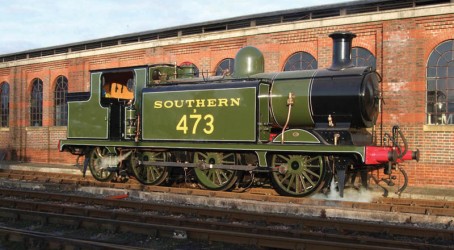Museums
Running along the picturesque border between East and West Sussex is one of the most famous heritage steam railways in Britain. The Bluebell Railway first sprung to life in 1882 as part of the Lewes and East Grinstead line but closed in 1958 after passenger and freight use went into decline.
In response to the closure a group of enthusiasts formed a society which fought to revive the railway. In 1960 a nine-mile stretch of the line between Sheffield Park and Kingscote, with an interim station at Horsted Keynes, reopened as a private enterprise.
Today, the Bluebell Railway and its vintage trains whisks passengers away into the past, to the age of steam where old engines, carriages, wagons, equipment and rail workers bustle with action and excitement.
In the spring the line is adorned with primroses, daffodils and, surprise, surprise, bluebells, but it is particularly during the winter months that the sights, smells and sounds of a travelling steam train conjure up a nostalgic atmosphere.
The stations are beautifully preserved, but it is Horsted Keynes, restored to the style of the 1920s Southern Railway, that looks the most impressive out of the three.
Eagle-eyed visitors will recognise that Bluebell’s stations have often appeared in films and television programmes, most recently ITV’s period drama Downton Abbey.
At Sheffield Park dozens of steam engines and carriages, both operational and those undergoing overhaul, can be seen. The engines currently in the shed include Southern Railway’s 928 Stowe V “Schools” (1934), 1618 Class U (1928) and the 541 Class Q (1939).
The oldest engine among the collection, Fenchurch, stands out from the rest. The locomotive became famous in the 1950s when it was the oldest working engine on the British Railways network.
Located across the platform at Sheffield Park is a recent addition to the station. A well-laid out museum narrates the story of the Lewes-to-East Grinstead line, which carried passengers and goods such as milk, coal and timber for many decades.
Modern displays and interactive exhibits reveal a wealth of information about the Industrial Revolution and railway pioneers.There’s a fascinating collection of signalling equipment, and a Bluebell Signaller computer game for enthusiasts to have a go at.
Work began three years ago to extend the railway to East Grinstead. The extension should open later this year.
Bluebell Railway facts and figures
- The Sheffield Park-to-Kingscote line is nine miles long.
- The 18-mile return trip takes 90 minutes.
- The speed limit on the railway line is 25mph.
- A tunnel, 731 yards long, forms part of the railway.
- Bluebell is home to 30 steam engines and 150 pre-war carriages and wagons.

5 things to see
- All aboard: Take a country ride on a steam train, in first or third class carriages.
- The famous Fenchurch: Built in 1872, this locomotive is the oldest in the collection.
- Restored Chesham carriages: Catch a glimpse of four 19th-century Metropolitan Railway wooden coaches.
- Horsted Keynes: This wonderfully preserved station has been seen on TV screens around the world.
- Sheffield Park museum: Find out about the history of the railways and see hundreds of artefacts on display.